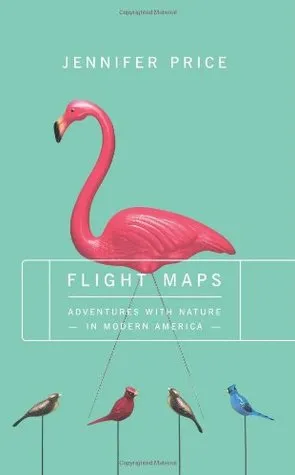Flight Maps: Adventures With Nature In Modern America
By (author): "Jennifer Price"
Publish Date:
1999
ISBN0465024866
ISBN139780465024865
AsinFlight Maps: Adventures With Nature In Modern America
Original titleFlight Maps: Adventures with Nature in Modern America
Our ReviewFlight MapsFor this unusual foray into nature writing, Jennifer Price doesn't go off into the mountains. She goes where the vast majority of American have their most consistent experiences of Nature -- in their front yards, in the malls, and in front of their television screens. Price is interested in finding out what Nature with a capital "N" means to Americans, and those are the places that reflect our hopes and desires surrounding Nature while also illuminating our philosophical and economic relationships with Nature. We have become attached to the notion of Nature as a realm Out There, apart from our hectic modern lives. Our social systems are in rapid flux, with only tenuous moorings. Nature seems to offer a timeless anchor. It is the ultimate reality to which we can appeal. As Price makes clear throughout the book, Nature is not actually Out There, but all around us and in everything we create -- no matter how "artificial," all objects must derive in some fashion from natural resources. To get to the source of current attitudes, Price begins at an earlier era in American history, right at the transition point when the mythos of Nature was first being formulated. She takes as her case study the extinction of the passenger pigeon, but instead of searching for the causes of this extinction, she tries to understand how the people of that time experienced their relationship to the pigeons. Pioneers saw the huge flocks, numbering in the hundreds, but as the birds' numbers dwindled, their main consumers -- diners at Delmonico's, one of the first elegant New York restaurants, which featured wild game regularly; and trap shooters who imported the wild birds for tournaments -- never saw passenger pigeons in their native habitat. This disconnect increased as people began using wild nature imported from areas farther and farther away. A fashion for whole birds and bird parts on women's hats caused a crisis that resulted in the first Audubon societies, as people became aware that their actions were causing perhaps irreparable damage to wild nature. A developed view of wild nature as a separate and elevated realm (for example, appeals to the motherhood of egrets being violated when the birds were shot on their nests) set the tone for subsequent attitudes.The elevation of Nature continued apace in contrast to the artificial creations of humanity. The pink flamingo plastic lawn ornament with its "unnatural" eye-popping colors stands in here for a whole class of objects that became singled out. But there is "nature" in a pink flamingo -- namely the materials that went into it. It became a symbol of unreal, inauthentic mass culture, as opposed to the real, authentic Nature Out There. The desire to surround oneself with the authenticity of Nature while living in an industrialized, consumer society led to stores like the Nature Company, where people could commune with Nature in a mall and take a little home with them. Nature as timeless authority was coopted to hawk an incredible variety of products -- most notably cars -- and to serve as an icon on television shows. Overall, Flight Maps has the effect of bringing to the fore more or less subconscious assumptions about Nature to which we have all been exposed. Since Price's intention is to illuminate attitudes, she does not offer a program for reintegrating nature, both the wild and transformed, into our awareness, but I could not help but be reminded of The Consumer's Guide to Effective Environmental Choices: Practical Advice from the Union of Concerned Scientists, which details exactly how much nature is going into the things that we buy, whether or not we think of them as Nature. --Laura Wood, Science & Nature Editor
